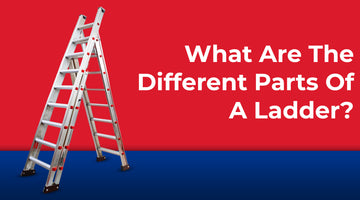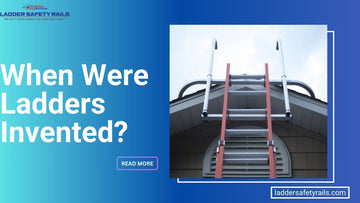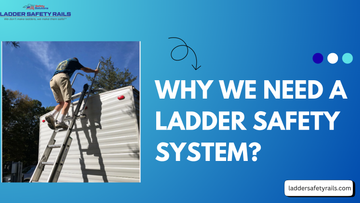
Ladders are essential tools in various industries and households. If you're painting a wall, fixing a roof, or reaching a high shelf, ladders come in handy. But have you ever wondered what all the different parts of a ladder are called and how they function? Understanding the anatomy of a ladder not only helps in using it correctly but also ensures safety.
Now let's explore the different parts of a ladder and their significance.
Basic Ladder Anatomy:
-
Frame:
The frame is the backbone of the ladder, providing structure and support. It's typically referred to as the two parallel rails adjoining the rungs. Frames are made of materials like aluminum, fiberglass, or wood, each offering different benefits in terms of weight, durability, and conductivity.
-
Rungs:
Rungs are the horizontal steps that you stand on while climbing a ladder. They are spaced evenly along the length of the ladder and are essential for providing stability and safe footing. Rungs of a ladder can be round or flat depending on the ladder type and are designed with a texture or grip to prevent slipping.
-
Meaning of Rungs:
Rungs are essentially the steps on a ladder, usually round or flat, and spaced evenly along the length of the ladder.
-
Steps:
Steps are similar to rungs but are specifically found on step ladders. Unlike rungs, steps are wider and provide a more comfortable platform for standing. Step ladders are typically used for tasks at lower heights where frequent climbing and standing are required.
-
Steps vs. Rungs:
While rungs are used on straight and extension ladders, steps are specific to step ladders. They provide a more stable platform for tasks that require standing for longer periods and are used at lower height levels.
Types of Ladders:

-
Step Ladder:
A step ladder is a self-supporting portable ladder with flat steps and a hinged design. It's perfect for indoor tasks and provides a stable platform for working.
-
Extension Ladder:
An extension ladder consists of two or more sections that can be extended to reach higher places. It's ideal for outdoor tasks like painting or roof work.
Parts of a Step Ladder:

-
Front Rails:
The front rails of a step ladder are the vertical sides that make up the front section of the ladder. These rails are crucial for providing structural support and stability. They are typically made from sturdy materials like aluminum or fiberglass to withstand weight and pressure. The front rails are where the steps are attached and are essential for maintaining the ladder's balance while in use.
-
Rear Rails:
The rear rails are the vertical sides of the ladder's back section. These rails are connected to the front rails utilizing spreaders. The primary function of the rear rails is to support and stabilize the ladder, ensuring that it remains upright and secure while in use. They are integral to the ladder's overall stability, especially when it is in an extended position.
-
Steps :
The steps on a step ladder are the flat, wide surfaces where users stand while working. These steps are designed to be comfortable and safe, providing ample space for the feet and reducing the risk of slips and falls. Steps are usually constructed with non-slip materials or textures to enhance grip and prevent accidents. The spacing between the steps is designed to allow for comfortable use, taking into account the average stride of users.
-
Spreaders:
Spreaders are metal bars that connect the front and rear rails step of a ladder. Their main role is to keep the ladder in an open position, preventing it from collapsing or folding unintentionally. Spreaders also contribute to the ladder's stability by ensuring that the distance between the front and rear rails remains consistent. They are typically spring-loaded or manually operated for ease of use.
-
Platform:
Some step ladders are equipped with a platform at the top. This platform provides additional stability and a larger surface area for standing. It also offers a convenient place to hold tools or other items, reducing the need for frequent trips up and down the ladder. The platform is especially useful for tasks that require both hands, as it allows users to work more comfortably and safely from a stable position.
Parts of an Extension Ladder
-
Base Section:
The base section is the stationary bottom part of an extension ladder. It remains fixed in place while the upper sections extend and retract. The base section is designed to provide a stable foundation and support the entire ladder when it is in use. It typically features ladder shoes to enhance stability on different surfaces.
-
Fly Section:
The fly section is the part of the extension ladder that can be extended or retracted to adjust the ladder's height. It slides up and down the base section, allowing users to reach varying heights as needed. The fly section is essential for achieving the desired working height, and its smooth operation is crucial for safe and effective use.
-
Rung Locks:
Rung locks are mechanisms that secure the fly section at the desired height. They prevent the fly section from sliding down unintentionally, ensuring that the ladder remains at the chosen height while in use. Rung locks are typically operated by levers or knobs and are crucial for maintaining ladder stability and safety.
-
Pulleys and Cables:
Pulleys and cables are used to raise and lower the fly section of an extension ladder. They provide a mechanical advantage, making it easier to adjust the ladder's height. The pulleys guide the cables smoothly, while the cables transmit the force needed to move the fly section. This system allows for precise height adjustments with minimal effort.
-
Ladder Shoes:
Ladder shoes are the feet of the ladder and play a crucial role in its stability. They often feature slip-resistant materials or designs to prevent the ladder from sliding on various surfaces. Ladder shoes are designed to provide a stable base and reduce the risk of accidents caused by shifting or slipping.
Additional Ladder Features:
-
Ladder Fold:
Many ladders are designed to be foldable for easy storage and transport. This feature is particularly useful for step ladders, allowing them to be compactly stored when not in use. Folding ladders also facilitate convenient transportation to different job sites or storage areas.
-
Ladder Extension Legs:
Some ladders come with extension legs that can be added or adjusted to provide extra height or stability on uneven surfaces. Extension legs help to level the ladder and ensure a safe working position, especially when working on slopes or uneven ground.
Safety Tips:
-
Regular Inspection:
It is essential to inspect your ladder regularly before each use. Check for any signs of damage, such as bent rails, loose steps, or worn-out parts. Regular inspections help identify potential issues that could compromise safety, allowing for timely repairs or replacements.
-
Proper Usage:
Always use the ladder according to its intended purpose and specifications. Avoid exceeding the weight limit and ensure that the ladder is set up on a stable, level surface. Following these guidelines helps prevent accidents and ensures safe and effective use of the ladder.
Ladder Safety Products:
Ladder Safety Rails:

One of the most important products to enhance ladder safety is the Ladder Safety Rails. These rails provide additional stability and security while working at heights. They attach easily to most ladders, offering handrails that can significantly reduce the risk of falls and accidents. Ladder Safety Rails are particularly useful for tasks that require prolonged use of a ladder, as they provide a safe and comfortable grip, allowing users to focus on their work without worrying about losing balance.
Original Softouch Bumpers:

Another essential safety product is the Original Soft Touch Bumpers. These bumpers are designed for stabilizers and ladder attachments to protect the surfaces it rests against. Made from durable, soft materials, they prevent scratches and dents on walls and other surfaces, while also adding a layer of grip to keep the ladder securely in place. Softouch Bumpers are a must-have for anyone concerned about maintaining the integrity of their home or workspace while using a ladder.
Understanding the different parts of a ladder is essential for safe and effective use. If you're using a step ladder or an extension ladder, knowing its anatomy helps in proper handling and maintenance. For high-quality ladder safety products, check out Ladder Safety Rails. Investing in Ladder Safety Rails and Original Softouch Bumpers will ensure you have the safest and most efficient ladder setup possible.
FAQs:
1- What are rungs on a ladder?
Rungs are the horizontal bars you step on when climbing a ladder. They provide support and stability.
2- What are steps on a ladder called?
Steps on a ladder are simply called "steps," especially on step ladders where they are flat and wide.
3- What is the steps of a ladder called?
The steps of a ladder can also be referred to as rungs, particularly on straight and extension ladders.
4- Are there different types of ladders?
Yes, there are various types of ladders including step ladders, extension ladders, and multi-purpose ladders, each designed for specific tasks.
5- How often should ladders be inspected?
Ladders should be inspected before each use and regularly maintained to ensure they are in good working condition.
Read More Blogs Here:





